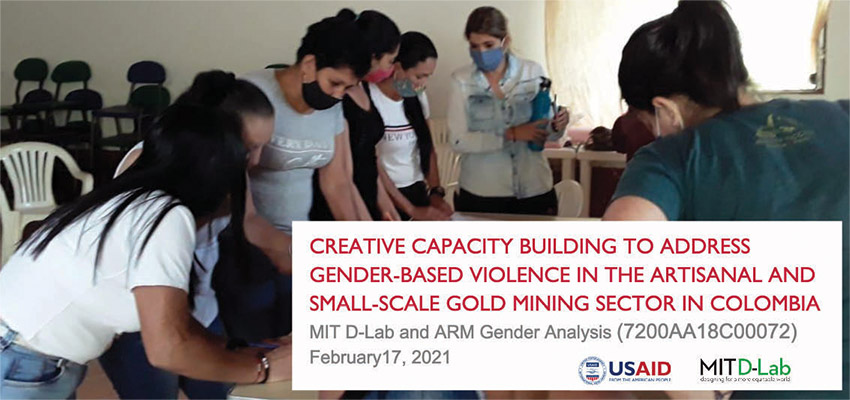
Introduction
The United States Agency for International Development’s (USAID) Resilient, Inclusive, and Sustainable Environments (RISE) Challenge was created to fund interventions that prevent and respond to gender-based violence (GBV) across programs that address the access, use, control, and management of natural resources. Responding to GBV can enhance environmental action and women’s empowerment but tackling one issue without the other is unlikely to succeed. USAID’s RISE Challenge aims to fund multifaceted GBV interventions that can be effectively integrated into USAID and partners’ environmental programming and investments.
There is solid literature and emerging evidence about the linkage between extractive industries, in particular in regions dominated by mining, and GBV (Oxfam international 2017, Oxfam America, 2016). In these male-dominated environments, women suffer harassment, discrimination, sexual violence, domestic violence, and economic violence. In addition, when women have increased economic involvement in mining activities or take on roles as local leaders, domestic violence spikes as a consequence of a perceived reversal of traditional gender roles. Based on needs assessments conducted in 2018 in Bajo Cauca, Colombia by Jaime Arteaga & Asociados (JAA) and in Bajo Cauca and Los Andes by MIT D-Lab, it has become evident that similar GBV linked to the mining industry is experienced in these regions.
Artisanal and small-scale gold mining (ASGM) is responsible for approximately 60% of gold production in Colombia. Mining is a traditionally masculine sector globally. This is also the case in Colombia where only 17% of the ASGM labor-force is composed of women and women’s organizations are excluded from conversations about mining as it is not recognized as a “woman’s issue.” Traditional patriarchal structures, machismo, and gender inequality that can often be part of the Colombian social, political, economic, and cultural context are exacerbated in mining regions. Very few women occupy positions of authority in mining organizations and they normally carry out activities considered non-central to gold-extraction that require little to no qualification and receive limited economic or social recognition. These marginal mining activities include the work of 1) “machadoras,” women that arrive early in the morning at mining sites, seeking permission from owners or managers to use small hammers to glean rock from tailings discarded by teams of male miners who often use machinery for excavation, and 2) “barequeros,” who pan for gold in muddy riverbanks where they are subjected to working conditions that result in malaria, tropical fever, and parasitic disease. According to the MIT D-Lab needs assessment conducted in January 2019, machadoras and barequeros are often exploited by middlemen when engaging in the ASGM value chain. These women carry out other economic activities to increase their income, for instance running informal food businesses or, in the case of Los Andes, working as seasonal coffee pickers. Furthermore, in both of the program’s targeted regions sex work is rampant.
The gender analysis was designed to inform a 22-month program that combines MIT D-Lab’s Creative Capacity Building (CCB) methodology that enhances voice and agency and Public Narrative, a movement building approach developed by Professor Marshall Ganz from the Harvard Kennedy School to address economic gender-based violence and environmental degradation in the ASGM sector in Antioquia, Colombia. The three, three-day movement building workshops will take place in April, July, and October of 2021 and an additional one-day Advocacy Capacity Building workshop will be held in each of the two program regions in July 2021. Also, in July 2021, a group of women beneficiaries will travel to Bogota to meet with women miners from other parts of the country to discuss the inclusion of GBV guidelines in ARM’s Fairmined Standards. Finally, in March 2022, women from each program association will participate in a National Forum in Bogota where they will meet with policymakers to present their recommendations for diminishing GBV and environmental degradation in the ASGM sector throughout Colombia.
The program targets two regions and four municipalities engaged in gold mining in Antioquia, Colombia.
- Santa Rita – located in Andes, Santa Rita has a population of 44,199 and the main economic activity is coffee production, followed by mining.
- El Bagre – the largest municipality in the region of Bajo Cauca, El Bagre has a population of 47,642 (65% of the population residing in urban areas and 35% in rural areas) and mining is the main economic activity.
- Zaragoza – also located in Bajo Cauca, Zaragoza, which is home to two indigenous reservations, has a population of 25,703 (47% of the population living in urban areas and 53% in rural). Agriculture is the main economic activity, with gold production as an additional dominant economic activity.
- Niché – the program’s third Bajo Cauca locale has a population of 27,354 (53% urban and 47% rural) and mining is the dominant economic activity, occupying 4.14% of the total municipal territory and in some places displacing livestock activity.
All three municipalities in Bajo Cauca experience armed conflict and production of illicit crops such as coca.
More information
MIT D-Lab Inclusive Economies Program
Contact
Libby McDonald, MIT D-Lab Lecturer; MIT D-Lab Inclusive Economies lead

